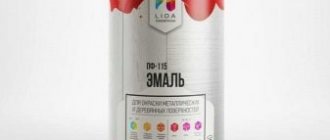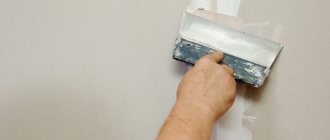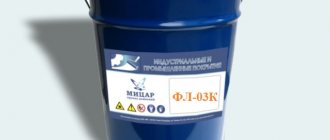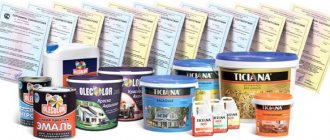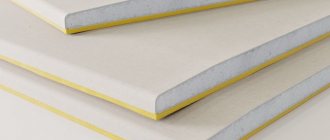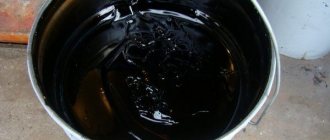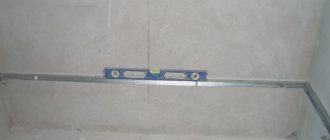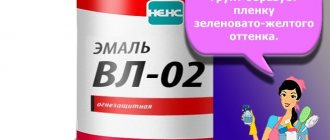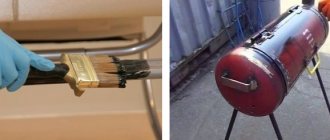GOST R 51693-2000 Group L25
STATE STANDARD OF THE RUSSIAN FEDERATION ANTI-CORROSION PRIMERS General technical specifications Anticorrosion primers. General specifications
OKS 87.040.20 OKP 23 1200 23 1300 23 1600 23 8810 23 8860
Date of introduction 2002-01-01
Preface
1 DEVELOPED by the Technical Committee for Standardization TC 195 “Paint and Varnish Materials”, OJSC “NPF “Spectrum LK” INTRODUCED by the State Standard of Russia
2 ADOPTED AND ENTERED INTO EFFECT by Resolution of the State Standard of Russia dated December 22, 2000 N 401-st
3 INTRODUCED FOR THE FIRST TIME Amendment published in IMS No. 7, 2009 Amendment made by the database manufacturer
Designation of primers by type of film-forming substance
Table A.1
| Name of primers according to the type of film-forming substance | Designation of primers | Name of the main film-forming substances |
| Alkyd-acrylic | AC | Copolymers of acrylates with alkyds |
| Bituminous | BT | Natural asphalt and asphaltites. Artificial bitumen. Peki |
| Glypthal | GF | Alkyd glycerophthalate resins (glypthal) |
| Rosin | KF | Rosin and its derivatives: calcium, zinc resinates, etc., rosin esters, rosin-maleic resin |
| Rubber | CC | Divinylstyrene, divinylnitrile and other latexes, chlorinated rubber, cyclo rubber |
| Organosilicon | KO | Organosilicon resins - polyorganosiloxane, polyorganosilazanosiloxane, organosilicon-urethane and other resins |
| Oil- and alkyd-styrene | MS | Oil-styrene resins, alkyd-styrene resins (copolymers) |
| Oily | MA | Vegetable oils |
| Melamine | ML | Melamine-formaldehyde, alkyd-melamine-formaldehyde resins |
| Urea | MCH | Urea-formaldehyde, alkyd-urea-formaldehyde, alkyd-urea-melamine-formaldehyde resins |
| Nitrocellulose | NC | Varnish colloxylines, nitroalkyd compositions (nitroglyphthals, pytropentaphthals, etc.), nitrocellulose-urethane, nitroaminoformaldehyde |
| Pentaphthalic | PF | Alkyd resins pentaerythritol phthalate (pentaphthalates) |
| Perchlorovinyl and polyvinyl chloride | HV | Perchlorovinyl resins, polyvinyl chloride resins |
| Polyacrylic | AK | Copolymers (and polymers) of acrylic and methacrylic acids, their esters and other derivatives with styrene, vinyl acetate and other vinyl monomers, as well as those cured with isocyanates |
| Polyurethane | UR | Polyurethanes based on polyhydric alcohols and polyisocyanates |
| Polyester unsaturated | PE | Unsaturated polyester resins |
| Copolymer-vinyl chloride | HS | Copolymers of vinyl chloride with vinyl acetate, vinylidene chloride, vinyl butyl ether and other vinyl monomers |
| Phenolic | FL | Phenol-formaldehyde resins (modified, 100%) based on phenols, cresols and xylenols, oil-phenolic resins |
| Fluoroplastic | FP | Ethylene fluoride derivatives; polytetrafluoroethylene, polytrichlorofluoroethylene |
| Chlorinated polyethylene | HP | Chlorosulfonated polyethylene, chloropolyethylene, chloroplypropylene |
| Epoxy | EP | Epoxy, alkyd epoxy, nitrocellulose epoxy, alkyd-melamine-epoxy, epoxyurethane and other epoxy-modified resins |
| Epoxy ester | EF | Epoxides modified with fatty acids from vegetable oils |
| Ethrifthalic | THIS | Alkyd etriol phthalate resins (trimethylolpropanphthalic) |
| Petroleum polymer | NP | Resins based on oil pyrolysis products, oil distillation bottoms (indene, cyclo-, dicyclodienes, styrene pyroplasts and its derivatives) |
2 Normative references
This standard uses references to the following standards:
GOST 9.401-91 Unified system of protection against corrosion and aging. Paint and varnish coatings. General requirements and methods of accelerated testing for resistance to climatic factors
GOST 9.402-80 Unified system of protection against corrosion and aging. Paint and varnish coatings. Preparing metal surfaces before painting
GOST 9.403-80 Unified system of protection against corrosion and aging. Paint and varnish coatings. Test methods for resistance to static effects of liquids
GOST 12.1.005-88 System of occupational safety standards. General sanitary and hygienic requirements for the air in the working area
GOST 12.1.016-79 System of occupational safety standards. Work area air. Requirements for methods for measuring concentrations of harmful substances
GOST 12.1.044-89 (ISO 4589-74) System of occupational safety standards. Fire and explosion hazard of substances and materials. Nomenclature of indicators and methods for their determination
GOST 12.3.002-75 System of occupational safety standards. Production processes. General safety requirements
GOST 12.3.005-75 System of occupational safety standards. Painting works. General safety requirements
GOST 12.4.011-89 System of occupational safety standards. Protective equipment for workers. General requirements and classification
GOST 12.4.021-89 System of occupational safety standards. Ventilation systems. General requirements
GOST 6806-73 Paint and varnish materials. Method for determining film elasticity during bending
GOST 8420-74 Paint and varnish materials. Methods for determining conditional viscosity
GOST 8832-76 (ISO 1514-84) Paint and varnish materials. Methods for obtaining paint coatings for testing
GOST 9825-73 Paint and varnish materials. Terms, definitions and designations
GOST 9980.1-86 Paint and varnish materials. Acceptance rules
GOST 9980.2-86 (ISO 842-84, ISO 1512-74, ISO 1513-80) Paint and varnish materials. Sampling for testing
GOST 9980.3-86 Paint and varnish materials. Package
GOST 9980.4-86 Paint and varnish materials. Marking
GOST 9980.5-86 Paint and varnish materials. Transportation and storage
GOST 14192-96 Marking of cargo
GOST 15140-78 Paint and varnish materials. Methods for determining adhesion
GOST 17537-72 Paint and varnish materials. Methods for determining the mass fraction of volatile and non-volatile, solid and film-forming substances
GOST 19007-73 Paint and varnish materials. Method for determining the time and degree of drying
GOST 19433-88 Dangerous goods. Classification and labeling
GOST 27271-87 Paint and varnish materials. Expiration date control method
GOST R 51121-97 Non-food products. Information for the consumer. General requirements
3 Definitions
In this standard, the following terms with corresponding definitions apply:
3.1 primer: A suspension of a pigment or a mixture of pigments with fillers in a film-forming substance, which after drying forms an opaque, uniform film with good adhesion to the painted surface and coating layers and is intended to increase the protective properties of coating systems.
3.2 corrosion: Physico-chemical interaction between the metal and the environment, as a result of which the properties of the metal change and the functional characteristics of the metal, the environment or the technical system that includes them often deteriorate.
3.3 anti-corrosion primer: A primer applied to metal surfaces to protect against the occurrence and development of corrosion processes and to ensure increased adhesion of coating layers of paint and varnish materials to the surface being painted.
4 Classification
4.1 Anti-corrosion primers (hereinafter referred to as primers) are classified according to the type of film-forming substance and designated according to GOST 9825 (Appendix A).
5 General technical requirements
5.1 Primers are manufactured in accordance with the requirements of this standard and regulatory or technical documents for a specific brand of primer, according to the recipe and technological regulations approved in the prescribed manner.
5.2 Regulatory documents (ND) or technical documents (TD) for a specific brand of primer indicate the scope of its application and the conditions for the formation of coatings.
5.3 Characteristics
5.3.1 Primers must comply with the requirements and standards specified in Table 1.
Table 1
| Meaning | |||
| Indicator name | Organic primers | Water-dispersion primers | Test method |
| Primer performance: | |||
| 1 Mass fraction of non-volatile substances, %, not less | 13,0 | 48,0 | According to GOST 17537 |
| 2 Conditional viscosity at temperature (20.0±0.5) °C according to a VZ-246 type viscometer with a nozzle diameter of 4 mm, s | 13-180 | 30-180 | According to GOST 8420 |
| 3 Drying time: for natural drying primers up to degree 3 at a temperature of (20±2) °C, h, no more: | According to GOST 19007 and 9.4 of this standard | ||
| for epoxy primers | 36 | — | |
| for everyone else | 24 | 5 | |
| for hot-drying primers, h, no more | 4 | 2 | |
| 4 Viability (shelf life) after mixing the components at a temperature of (20±2) °C, h, not less: | Not defined | According to GOST 27271 | |
| for epoxy primers | 4 | ||
| for everyone else | 6 | ||
| 5 Hazard class and subclass (flash point in a closed cup, °C): | According to GOST 19433 and 9.5 of this standard | ||
| 3.1 | Less than minus 18 | — | |
| 3.2 | Minus 18 or more, but less than 23 | — | |
| 3.3 | 23 or more, but less than 61 | — | |
| 9.1 | More than 61 but less than 90 | — | |
| Coverage indicators: | |||
| 6 Appearance of the coating | After drying, the primer should form a uniform surface without craters, pores or wrinkles. | After drying, the primer should form a uniform surface without craters, pores or wrinkles. | According to 9.6 of this standard |
| 7 Coating adhesion, points, no more | 2 | 2 | According to GOST 15140 |
| 8 Film elasticity when bending, mm, no more | 3 | 3 | According to GOST 6806 |
| 9 Resistance of the coating to static influence at a temperature of (20±2) °C, h, not less: | According to GOST 9.403, method A and 9.7 of this. standard | ||
| water | 24 | 24 | |
| sodium chloride solution with a mass fraction of 3% | 8 | 8 | |
| 10 Resistance of the coating to static exposure to chemically aggressive environments at a temperature of (20 ± 2) °C, h, not less | 2 | 2 | According to GOST 9.403, method A and 9.8 of this standard |
5.4 Packaging
5.4.1 Packaging of primers - according to GOST 9980.3.
5.5 Marking
5.5.1 Marking of primers - according to GOST 9980.4.
5.5.2 For primers intended for retail trade, information for the consumer is in accordance with GOST R 51121.
5.5.3 Transport marking - according to GOST 14192 and GOST 19433.
6 Safety requirements
6.1 The production of primers must comply with the requirements [] and [].
6.2 Safety of work associated with the production, testing and use of primers - in accordance with GOST 12.3.002 and GOST 12.3.005.
6.3 Primers can be approved for production, sale and use only after a hygienic assessment and in the presence of a hygienic certificate issued by the State Sanitary and Epidemiological Supervision authorities of the Russian Federation.
6.4 To characterize toxicity in ND or TD for a specific brand of primer, the following is given:
— information about the toxic components included in the primer, indicating their hazard class, physical state, maximum permissible concentration in the air of the working area;
— types and consequences of dangerous effects on the human body of toxic components of the primer;
— personal protective equipment for those working with this primer in accordance with GOST 12.4.011.
6.5 The concentration of harmful substances in the air of the working area during the manufacture and application of primers should not exceed the maximum permissible concentrations for air in the working area (MAC), estimated safe exposure levels (SAEL) according to GOST 12.1.005 and hygienic standards [], [].
6.6 Monitoring the content of harmful substances in the air of the working area is organized in accordance with GOST 12.1.005.
6.7 Determination of the content of harmful substances in the air of the working area is carried out according to methods developed in accordance with GOST 12.1.005 and GOST 12.1.016 and approved by the State Sanitary and Epidemiological Supervision authorities of the Russian Federation.
6.8 All work related to the production of primers is carried out with general supply and exhaust and local ventilation operating in accordance with GOST 12.4.021.
6.9 All work related to the application of primers in premises is carried out with general supply and exhaust and local ventilation operating in accordance with GOST 12.4.021.
6.10 The ND or TD for a specific brand of primer provides the following fire hazard characteristics of the most dangerous components of the primer, determined according to GOST 12.1.044:
— flash point in an open crucible;
— ignition temperature;
— auto-ignition temperature;
— temperature limits of ignition.
6.11 Primary fire extinguishing agents and fire extinguishing compositions are indicated in the ND or TD for a specific brand of primer.
6.12 Additional safety requirements, determined by the specifics of the manufacture and use of the primer, are indicated in the ND or TD for a specific brand of primer.
7 Environmental requirements
7.1 During the production and use of primers, solid, gaseous and liquid wastes are generated, which cause air and water pollution.
7.2 During the production and use of primers, hygienic requirements for the protection of atmospheric air in populated areas must be observed [].
7.3 In order to protect the atmospheric air from pollution by emissions of harmful substances, constant monitoring of compliance with maximum permissible emissions (MPE) is organized using calculation and instrumental methods approved for use by the federal executive body specially authorized in the field of atmospheric air protection.
7.4 The concentration in the atmospheric air of harmful substances contained in emissions from enterprises is determined in accordance with [] and [].
7.5 Concentrations of harmful chemicals released from primers during storage and transportation, as well as from coatings based on them during operation, should not, taking into account their dispersion in the atmosphere, exceed the average daily maximum permissible concentrations (MAC) and maximum single concentrations (MAC) in atmospheric air of populated areas, as well as estimated safe exposure levels (SAEL) according to [8], [9].
7.6 In order to protect the environment from pollution by wastewater, control over its content in wastewater is organized in accordance with [10], [], [].
7.7 All liquid waste generated during filtering, washing of equipment, communications in the form of contaminated solvents is returned to production or collected in a special container and sent for disposal according to [13].
7.8 Neutralization of waste generated during cleaning of equipment and containers is carried out in accordance with the procedure for accumulation, transportation, neutralization and disposal of toxic industrial waste [13], as well as in accordance with [14] and [15].
8 Acceptance rules
8.1 Acceptance rules - according to GOST 9980.1.
9 Test methods
9.1 Sampling - according to GOST 9980.2.
9.2. Samples for testing are prepared in accordance with GOST 8832. The material of the surface to be painted, the method of applying the primer, the thickness of the coating, the number of layers, conditions and drying time are indicated in the ND or TD for a specific primer.
9.3 Preparation of metal surfaces before applying primer - according to GOST 9.402.
9.4 The drying time of primers is determined according to GOST 19007. For hot-drying primers, the degree and temperature of drying is indicated in the ND or TD for a specific brand of primer.
9.5 Assignment of primers to hazard class and subclass - according to GOST 19433; determination of flash point in a closed crucible - according to GOST 12.1.044.
9.6 The appearance of the primer coating is determined visually in natural or artificial diffused light, at a distance of about 0.3 m from the subject of inspection. In case of disagreement in assessing the appearance of the coating, the determination is carried out in natural light.
9.7 Determination of the resistance of the coating to the static effects of water or a 3% sodium chloride solution is carried out according to GOST 9.403; After completion of the test, the test sample in appearance must comply with the requirements specified in the ND or TD for a specific brand of primer.
9.8 Determination of the resistance of the coating to solutions of acids, alkalis and other chemically aggressive media is carried out according to GOST 9.403. To carry out the tests, use the material to which the coating is exposed during operation. After completion of the test, the test sample in appearance must comply with the requirements specified in the ND or TD for a specific brand of primer.
10 Transportation and storage
10.1 Transportation and storage - in accordance with GOST 9980.5.
11 Directions for use
11.1 Instructions for surface preparation and conditions for applying primer are given in the ND or TD for a specific material.
11.2 Compatibility of primers with enamels and putties - according to GOST 9.401.
11.3 Use of primers for painting specific metals - according to GOST 9.401.
12 Manufacturer's warranty
12.1 The manufacturer guarantees that primers comply with the requirements of this standard subject to storage and transportation conditions.
12.2 The guaranteed shelf life of primers is indicated in the ND or TD for a specific brand of primer.
APPENDIX A (for reference)
Designation of primers by type of film-forming substance
Table A.1
| Name of primers according to the type of film-forming substance | Designation of primers | Name of the main film-forming substances |
| Alkyd-acrylic | AC | Copolymers of acrylates with alkyds |
| Bituminous | BT | Natural asphalts and asphaltites. Artificial bitumen. Peki |
| Glypthal | GF | Alkyd glycerophthalate resins (glypthal) |
| Rosin | KF | Rosin and its derivatives: calcium, zinc resinates, etc., rosin esters, rosin-maleic resin |
| Rubber | CC | Divinylstyrene, divinylnitrile and other latexes, chlorinated rubber, cyclo rubber |
| Organosilicon | KO | Organosilicon resins - polyorganosiloxane, polyorganosilazanosiloxane, organosilicon-urethane and other resins |
| Oil- and alkyd-styrene | MS | Oil-styrene resins, alkyd-styrene resins (copolymers) |
| Oily | MA | Vegetable oils |
| Melamine | ML | Melamine-formaldehyde, alkyd-melamine-formaldehyde resins |
| Urea | MCH | Urea-formaldehyde, alkyd-urea-formaldehyde, alkyd-urea-melamine-formaldehyde resins |
| Nitrocellulose | NC | Varnish colloxylines, nitroalkyd compositions (nitroglyphthals, nitropentaphthals, etc.), nitrocellulose-urethane, nitroaminoformaldehyde |
| Pentaphthalic | PF | Alkyd resins pentaerythritol phthalate (pentaphthalates) |
| Perchlorovinyl and polyvinyl chloride | HV | Perchlorovinyl resins, polyvinyl chloride resins |
| Polyacrylic | AK | Copolymers (and polymers) of acrylic and methacrylic acids, their esters and other derivatives with styrene, vinyl acetate and other vinyl monomers, as well as those cured with isocyanates |
| Polyurethane | UR | Polyurethanes based on polyhydric alcohols and polyisocyanates |
| Polyester unsaturated | PE | Unsaturated polyester resins |
| Copolymer-vinyl chloride | HS | Copolymers of vinyl chloride with vinyl acetate, vinylidene chloride, vinyl butyl ether and other vinyl monomers |
| Phenolic | FL | Phenol-formaldehyde resins (modified, 100%) based on phenols, cresols and xylenols; oil-phenolic resins |
| Fluoroplastic | FP | Ethylene fluoride derivatives; polytetrafluoroethylene, polytrichlorofluoroethylene |
| Chlorinated polyethylene | HP | Chlorosulfonated polyethylene, chloropolyethylene, chloropolypropylene |
| Epoxy | EP | Epoxy, alkyd-epoxy, nitro-cellulose epoxy, alkyd-melamine-epoxy, epoxyurethane and other epoxy-modified resins |
| Epoxy ester | EF | Epoxides modified with fatty acids from vegetable oils |
| Ethrifthalic | THIS | Alkyd etriol phthalate resins (trimethylolpropanphthalic) |
| Petroleum polymer | NP | Resins based on oil pyrolysis products, oil distillation bottoms (indene, cyclo-, dicyclodienes, styrene pyroplasts and its derivatives) |
Oily soils
What is an oil primer? This is an alkyd mixture based on synthetic oil resins; it also contains grated paint and drying oil, thanks to these components you can choose the color of the primer. If the composition is supplied in the form of a spray or aerosol, the can must contain a solvent. And if the solution is in a metal can, then the composition will not contain solvents; it must be applied either with a roller or a brush.
To protect yourself from purchasing counterfeit, low-quality goods, you must purchase a solution that has a quality certificate. Such a mixture will have the best characteristics; an oil primer certificate is a document confirming that the product complies with GOST and the requirements of other regulatory documents.
Purpose
To ensure that the finishing material adheres firmly to the walls and ceiling, when performing interior repair work, the base must be covered with a primer mixture before painting or wallpapering. Thanks to priming, the finish will be durable, will not crack or fall off, and the wallpaper will not peel off or peel off.
The high technical characteristics of the primer allow it to significantly increase the adhesion rate of plaster, putty and finishing materials, so the walls and ceiling will remain attractive for a long time, remaining the same as they were immediately after the repair. There are many primer compositions on the market and in stores, and it is very easy for the average person to get confused, because it may not be clear which type is best to choose.
Purpose of wood processing
A primer for wood is an acrylic, alkyd, mineral and oil-based liquid containing resins, plasticizers, glue, antiseptics, pigments and other components that prepare the surface for further painting or varnishing. The choice of composition depends on the type of wood and the expected conditions of its use, and the type of subsequent staining.
When processing lumber, the primer performs a number of tasks:
- disinfects, destroying mold spores, putrefactive bacteria, parasite larvae;
- impregnates the top layer of the material, binds the fibers, fills the pores, smoothes the pile and creates a protective waterproof film that prevents erosive processes, swelling and destruction;
- Depending on the purpose, it evens out the color, emphasizes the natural wood grain, and hides stains;
- improves adhesive properties, helping to ensure optimal adhesion of surfaces;
- saves the consumption of varnishes and paints.
Primer compositions differ in the depth of penetration, the time required for complete drying, and the degree of protection created. Depending on the characteristics, some products are suitable only for interior work, others are also used for finishing wooden parts, walls of rooms and buildings outside.
Main advantages
The excellent characteristics of the oil primer give it the following advantages:
- serves as a reliable protection for the base, which is subsequently painted with any oil paint;
- products or structures made of wood acquire a high level of resistance to moisture;
- is a natural antiseptic for surfaces;
- Since the mixture can be tinted, it is very easy to decorate the primed base. In addition, the shade and texture of the primer will not be visible through the paint layer.
Types of oil-based primers
There are 2 types of acrylic and oil primers sold in stores:
- universal primers have the best technical characteristics, thanks to which these mixtures can be used for treating concrete and brick bases, but they cannot be used for priming any metals and wood. Universal primers are great for protecting walls and ceilings before wallpapering or painting;
- Primer-paints are used to coat wood and metals. In addition to effectively protecting the surface and enhancing adhesion, these oil-based primers also have antifungal properties. Usually available in white, so the primed surface looks like it has been painted.
Priming rules
The primer must match the composition of the paint that will be applied over the primer. The store purchases a suitable type of primer, as well as the following tools:
- a cuvette container with a ribbed area for spinning. This container will be used to pour the primer mixture;
- brush and roller for surface treatment;
- If you don’t have a stepladder, you need to buy a telescopic handle.
Before you start priming walls, ceilings, or any other structures and products, you need to remove dirt, dust, remnants of old finishing materials, greasy stains, and other contaminants from them. If metal is to be primed, it must be cleaned of rust.
The finished primer is poured into a ditch, a roller or brush is lowered into the mixture, passed over the ribbed surface several times to remove excess composition, after which the mixture is applied to the surface. It is advisable to apply two coats of primer, but make sure that the first coat of primer is completely dry before applying the second coat. Drying time depends on the temperature and humidity in the room. Even a beginner can handle priming; there is nothing difficult about it.
Main characteristics
Below are the technical characteristics of the oil primer.
Typically, these types of primers have a matte color, due to which they are considered universal because they can be tinted. Typically, an oil-based primer has a consumption of 50 to 100 grams per square meter, this parameter depends on what surface the mixture is applied to and what absorbent properties the base has.
The thickness of one layer of oil primer is less than 1 millimeter. Under normal conditions of use, the primer coat is completely dry in approximately 24 hours. After this time, you can begin applying the next layer. Before applying a layer of oil primer, the manufacturer recommends stirring the mixture thoroughly.
Application
At the first stage, we prepare the surface for applying the PRIMER - it must be clean and dry (the maximum permissible level of wood moisture is 12%). The varnish or paint coating must be removed using a solvent or by grinding (final abrasive with a grain size of 120-150). After sanding, carefully remove any resulting wood dust.
Öl-Grundierung wood primer for interior use must be mixed well before use and not diluted. Apply thinly with a spatula and distribute evenly. The amount of material applied is about 15 g/m2, depending on the type of wood, application method and other factors.
Within 30 minutes, smooth the surface treated with a spatula to remove streaks using a grinding machine with a white pad.
In floors with chamfers, level the primer with a brush in the longitudinal direction or use a machine with brushes in such a way as to remove excess primer from the chamfers. Or apply with a roller with the minimum possible flow rate without pressure to prevent the material from flowing into the chamfers. Then remove excess primer with a white pad or rag. Rub the primer into the chamfers with a rag.
To achieve uniformity and color saturation of the painted surface of combined floors, we recommend that before applying the primer, moisten the painted surface with water to raise the pile. In this case, the color intensity will increase.
A comprehensive system for protecting wooden flooring and furniture surfaces subject to particularly high loads consists of:
- applying Öl-Grundirung (1st layer);
- topcoat – as a topcoat you can choose either Premium Hartwachsöl. hard wax oil or Ecoline MultiTop varnish.
Drying and curing
Drying time for each layer is 8-10 hours (depending on temperature and air humidity). After drying, treat the surface with a polishing machine with a white pad.
GOST R 51693-2000 Anti-corrosion primers. General technical conditions
Professional experts advise that you must prime the surface of walls and ceilings before painting or wallpapering them. People who are far from the sphere of repair and finishing work may think that priming is not such an important procedure. However, experienced finishers say that priming the surface is a very important step during repairs; this procedure cannot be neglected. There are several types of primer compositions, one of the widely used ones is oil primer. The main properties, purpose and types of this soil will be discussed in this article.
